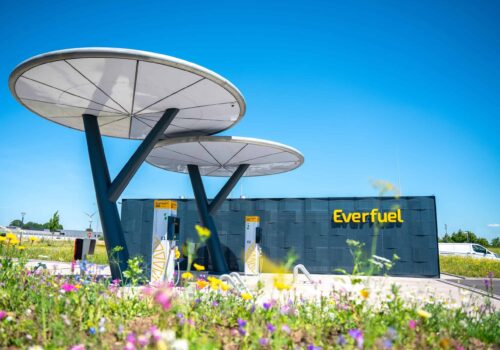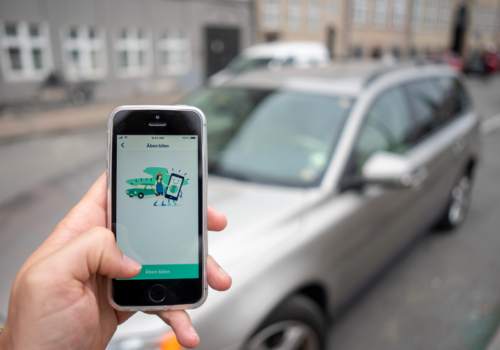The challenge
The transport sector emits around 20 per cent of Denmark’s total CO2e emissions, whereas inland transport, including lorries, delivery vans and buses, is responsible for about 32 per cent of the transport sector’s carbon emissions in Denmark.
For example, more than 99 per cent of Denmark’s 42,000 lorries still run on 93 per cent petrodiesel fuel. This figure demonstrates how the transport sector is working on the transformation process, as the lorries are fuelled by 7 per cent bi...
The transport sector emits around 20 per cent of Denmark’s total CO2e emissions, whereas inland transport, including lorries, delivery vans and buses, is responsible for about 32 per cent of the transport sector’s carbon emissions in Denmark.
For example, more than 99 per cent of Denmark’s 42,000 lorries still run on 93 per cent petrodiesel fuel. This figure demonstrates how the transport sector is working on the transformation process, as the lorries are fuelled by 7 per cent biodiesel. Yet it also highlights an unrealised capacity for further reducing heavy transportation’s carbon emissions.
The potential
The partnership aims to provide realistic solutions that are implementable within the foreseeable future and to contribute with genuine, significant reductions by 2030 while simultaneously preserving jobs and Denmark’s future competitiveness. Green transformation can be generated in three principal areas:
- The transport process can be further streamlined to reduce fuel consumption. This can be done through driving-pattern optimisation, capacity utilisation, off-hour deliveries, ...
The partnership aims to provide realistic solutions that are implementable within the foreseeable future and to contribute with genuine, significant reductions by 2030 while simultaneously preserving jobs and Denmark’s future competitiveness. Green transformation can be generated in three principal areas:
- The transport process can be further streamlined to reduce fuel consumption. This can be done through driving-pattern optimisation, capacity utilisation, off-hour deliveries, etc. It can also occur by lengthening combined vehicles and increasing the total weight of the vehicles themselves. Many of these initiatives can be implemented by the sector itself.
- A wider selection and greater use of green vehicles can be encouraged via subsidies. Converting the taxation system could promote the purchase of low-emission and zero-emission vehicles, and enlarging the refuelling and charging infrastructure for green fuels could break down barriers to the use of green vehicles
- Green fuels can be promoted. A decarbonisation requirement and tax exemption for sustainable fuels could secure a technology-neutral conversion process, while safeguarding Denmark’s competitiveness at the same time.
Recommendations
A model with a gradually increasing decarbonisation requirement for fuel suppliers in Denmark up to 2030. Since the recommendations from 2020, this has been partially realised through the expansion of the EU ETS system to road transport
Experiments should be launched to examine new vehicle configurations. Specifically, experiments should be launched involving double-trailer combined vehicles, in which the combined vehicle is made up of two standard semi-trailers (up to 32 metres)
To promote the market for heavy vehicles running on alternative fuels in Denmark, it
is proposed that a Danish subsidy scheme be set up for the first 10,000 heavy vehicles
that run on alternative fuels (such as biogas, electricity or hydrogen) up to 2030
Electrofuels are defined as the transport sector’s moon shot, but it is difficult to see
how they can be realised on a large scale before 2030. With an overarching goal for
a carbon neutral Denmark and Europe by 2050, it is necessary to launch the project
already now, so we can achieve the goal in time

The Climate Partnership for Inland Transport
Want to learn more about the climate partnership and explore the government and industry recommendations more in-depth? Fill in your information below and download the highlights
Cases
Contact
Danish Chamber of Commerce
Jesper Kronborg
[email protected]
About the partnership
Chairman
Jens Lund, Group CEO, DSV
Vice chairmen
Anne Kathrine, Steenbjerge, CEO, Ancotrans
Martin Danielsen, CEO, Schou-Danielsen, Logistik
Public partner
The Ministry of Transport
Private partners
- Hydrogen Denmark
- Biogas Denmark
- CONCITO
- Danish Construction Federation
- Danish Ports
- Danish Shipping- and Port Companies
- Danish Electric Vehicle Alliance
- Danish Energy Association
- Danish Chamber of Commerce
- Danish Freight Forwarders Association
- Confederation of Danish Industry
- Danish Passenger Transport
- Danish Fuel and Refineries
- FDM
- The Association of Professional Passenger Transport
- Green Transition Denmark
- Youth Climate Council of Denmark
- 3F Transport
- DTU
- Aalborg Universitet





